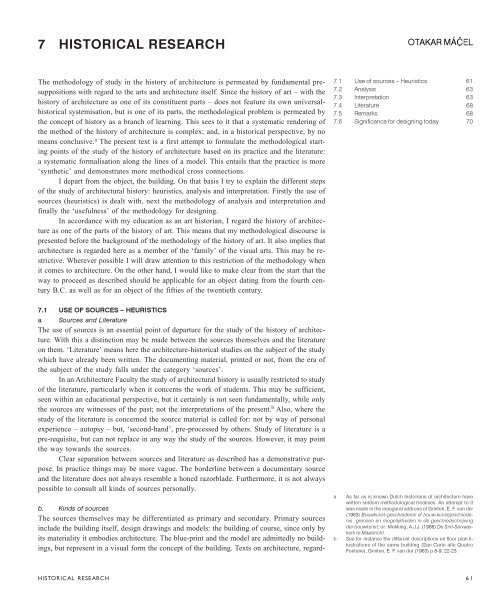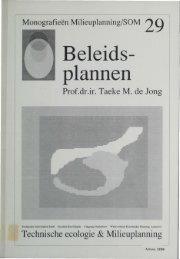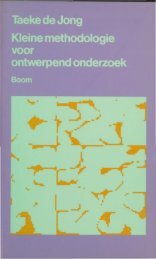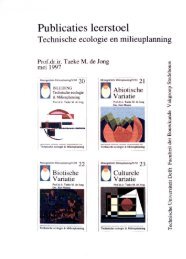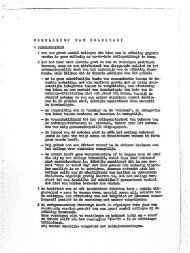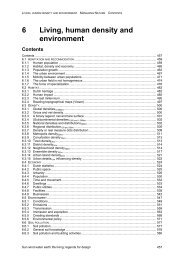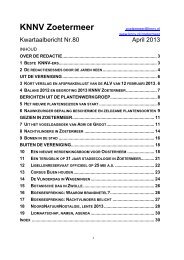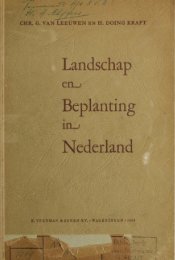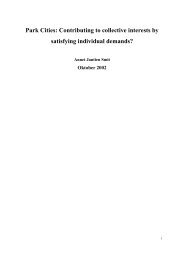A04 Naming components and concepts
A04 Naming components and concepts
A04 Naming components and concepts
- No tags were found...
Create successful ePaper yourself
Turn your PDF publications into a flip-book with our unique Google optimized e-Paper software.
Any historical study – <strong>and</strong>, perforce, architectural-historical ones – always focuses on theintentions <strong>and</strong> context at the time of the work itself. It is the only way to underst<strong>and</strong> the work:it is a conditio sine qua non. This way we may now experience a gothic church as impressiveby the materiality of its daring construction <strong>and</strong> the clear spaciousness, while in the middleages it was just surpassing materiality <strong>and</strong> the mutual symbolic functions of the parts establishingthe ‘experiencing’ of this architecture. The ‘delight in art’ at that time carried muchmore the stamp of theology than present-day appreciation; it was of a different order. However,this approach is only tentative: it is not only seldom that all data can be found, but acomplete experiential transition to the past is impossible; the work of a historian of architectureis done by necessity in the present. The past is over. Although underst<strong>and</strong>ing sources intheir original significance results in some access to the history, historiography is an activityof the present. Already in 1868 the historian Johann Gustav Droysen put it this way: “Unsereganze Wissenschaft beruht darauf, daß wir aus solchen noch gegenwärtigen Materialien nichtdie Vergangenheit herstellen, sondern unsere Vorstellungen von ihnen begründen, berichtigen,erweitern wollen, und zwar durch ein methodisch verfahren, das sich aus diesem ersten Lehrsatzentwickelt.” a Even when ‘our imaginings’ of the past are determined by today’s position ofthe historian, the importance of the transient ‘social relevance’ is not always relevant for analysis<strong>and</strong> interpretation of the sources. In the study the sources can only be understood within theoriginal context. In contrast, actuality can determine what is going to happen with the resultof the study. This may affect the selection of the theme of the study. It becomes clear thenwhere the historical approach <strong>and</strong> current social interests (‘relevance’) cross one another.With problems of monument in the national trust, for instance, the knowledge of the originalsignificance of a building plays a leading rôle since it is a factual testimony of the past. At thesame time its value as a remembrance, decisive for putting it on the list of monuments, restson an interpretation in the here <strong>and</strong> now. The rôle of ‘social relevance’ (present context of thebuilding) comes much more strongly to the fore during renovation <strong>and</strong> renewed usage.a. Context as a frame of referenceWhere the stage of analysis addresses the question ‘what’ the characteristics are of the workof architecture, the stage of interpretation addresses the question of the ‘how’ of these characteristics<strong>and</strong> their original significance. Although the building embodies its characteristics<strong>and</strong>, therefore, also its significance itself, it can not be understood by itself. The answers tothese questions can only be found in the inter-connection of the work with its contemporarycontext: a building does not come into being in a timeless vacuum, but in a specific historicalsituation. This entails that the pure object-driven approach of the architectural work mustyield to a broader approach, related to the historical context of its origins. This may call forstudy of the relationship of the architectural work with the contemporary aesthetic norm(s),technical know-how, the conventions <strong>and</strong> backgrounds of its use <strong>and</strong> study of (original) significanceof the architectural work transcending these categories. It may also be undertakenon a more general level (school, area, era). Not only determining <strong>and</strong> interpreting the characteristics<strong>and</strong> significance of the architectural work is important for study in architecturalhistory, but also their changes. In this way interpretation might have several aspects <strong>and</strong> levels.Since these aspects <strong>and</strong> levels always relate to one another, rendering them systematicallyis a difficult <strong>and</strong> schematic exercise by necessity. It also depends on the theme of thestudy. I have opted for arranging the interpretation according to the context of the architecturalwork, in this case the context of factual originating, the context of the functional use, thecontext of the style <strong>and</strong> the context of the iconographic <strong>and</strong> transcendental significance ofthe work. It is admittedly a heterogeneous systemisation, but it attempts to encompass <strong>and</strong>conclude the problem of interpretation. Allocating the architectural work within the historyof architecture would then require weighing all four contexts as they inter-relate.aDroysen, J.G. (1960) Grundriß der Historik: eine Enzyklopädieund Methodologie der Geschichte (1868), p.20.64 WAYS TO STUDY AND RESEARCH
. Context of the originatingThe most immediate context applicable to the architectural work is the one of the commissioner,the author (designer) <strong>and</strong> the constructor (building company). Together they embodythe conditions for the building to get into being, so that their rôles in that process should alwaysbe studied. The factual data on the commission, the author <strong>and</strong> execution should alreadyhave been determined by the critique of the sources. Here their specific rôles vis-à-visthe characteristics <strong>and</strong> intentions of the individual architectural work st<strong>and</strong> central. Studyingthe commission, the author <strong>and</strong> the building company can be an independent objective of astudy – separately or not – focused on the individual building or on a general theme.The commissionA commission, given by a principal, starts the designing <strong>and</strong> building. Compared to the art ofpainting, for instance, this is specific for architecture <strong>and</strong> for arts <strong>and</strong> crafts. Historicallyspeaking, this difference is of relatively recent origin, since the nineteenth century. This commissionincludes the destination, so the kind of use (type) of the building <strong>and</strong> the specificwishes <strong>and</strong> conditions of the commissioner. These wishes are inter-related with his socialposition <strong>and</strong> with his possible political ambitions. The study of the commission <strong>and</strong> the commissionermay choose several directions, but this aspect always marks the specific history ofthe originating of the building. The kind of commission <strong>and</strong> the position of the commissioneralso point to typological considerations.See e.g.:- Panofsky, E. (1946) Abbot Suger on the AbbeyChurch of St. Denis <strong>and</strong> its art treassures;- Boorsch, S. (1982-83) The Building of the Vatican.The Papacy <strong>and</strong> Architecture;- Ellis, R. <strong>and</strong> D. Cuff (1989) Architects’ people;- Dijkstra, Tj. (1991) De kunst van het opdrachtgeven.The author(s)If the commission starts the originating of a building, then the commissioner is its cause. Theauthor (designer, architect, master builder) is the one who outlines with his knowledge, purpose<strong>and</strong>, perhaps, talent the building. At first sight the author seems as a person less importantwhere it comes to the history of art <strong>and</strong> architecture, since the object of this discipline isprimarily the work of the author <strong>and</strong> not this person. In addition his alienation with the buildingcommences with the completion of the work with regard to the intentions of the maker.From this moment on the work may be understood by others in a different way than theauthor had in mind. Although the author is the cause of the building, he himself is not alwaysthe most important source of information. Many buildings are anonymous or only associatedwith just a name with a background. Nevertheless, the author is a crucial link in the chain ofthe interpretation of an architectural work. Author related considerations with regard to thebuilding include his training, professional experience <strong>and</strong> expertise, the relationship to thecommissioner <strong>and</strong> the intentions <strong>and</strong> ambitions inherent in the commission.An intermediary problem between the categories ‘author’ <strong>and</strong> ‘execution’ is the operationfor its own profession (from construction hut to the architects’ office). Knowledge ofthis may contribute to the insights into the social status of the author, the task distributionduring designing <strong>and</strong> the relationship with the executor.The literary genres on authors most common arethe monograph, the biography <strong>and</strong> the texts of theauthors themselves. In addition historical studies onthe profession <strong>and</strong> the education of architects arerelevant, e. g.:- Briggs, M.S. (1927) The architect in history(Pevsner, N. (1930-31) Zur Geschichte des Architektenberufs.);- Harvey, J.H. (1972) The mediaeval architect;- Müller, W. (1989) Architekten in der Welt derAntike;- Severin, I. (1992) Baumeister und Architekten.Studien zur Darstellung eines Berufst<strong>and</strong>es inPorträt und Bildnis;- Saunders, W.S. (1996) Reflections on architecturalpractices in the nineties;- Pfammatter, U. (1997) Die Erfindung des modernenArchitekten. Ursprung und Entwicklungseiner wissenschaftlich-industriellen Ausbildung.The executionWithout builders there is no building. In spite of that the building company plays a less importantrôle in the history of architecture, while it plays only an intermediate rôle, in a certainsense a hidden one, however indispensable it may be. Nevertheless, a minimum of knowledgeof this problem is needed from a factographic viewpoint. And what is more, the possibilitiesof execution of the design may influence the resulting Gestalt of the building. Theorganisational structure of a building enterprise may be of importance for conserving <strong>and</strong>passing the knowledge of building to future generations like in the Middle Ages – where theauthor <strong>and</strong> the enterprise worked together – in studying the building. If in the problem of theexecution the question of technical know-how is taken into account also, the significance ofthis contextual aspect increases. The building enterprise may be seen as the carrier of con-Examples in the literature on the execution include:- Grote, A. (1959) Der vollkommen Architectus.Baumeister und Baubetrieb bis zum Angang derNeuzeit;- Colombier, P. du (1973) Les chantiers des cathédrales:ouvriers, architectes, sculpteurs;- Binding, G. <strong>and</strong> N. Nußbaum (1978) MittelalterlicherBaubetrieb;- Vroom, W.H. (1981) De financiering van de kathedraalbouw.HISTORICAL RESEARCH 65
temporary technical knowledge. This knowledge determines, together with that of the author,the possibilities of materialisation of the design.A general typological survey is the one of- Pevsner, N. (1976) A history of the building types.Examples of monographical-typological literatureinclude:- D’Amico, S. <strong>and</strong> F. Savio (1954-1966) Enciclopediadello spettacolo (10 vol.);- Braunfels, W. (1969) Abendländische Klosterbaukunst;- Thompson, J.D. <strong>and</strong> G. Goldin (1975) The hospital,a social <strong>and</strong> architectural history;- Petersen, M.A. (1978) Gedetineerden onder dak;geschiedenis van het gevangeniswezen in Nederl<strong>and</strong>vanaf 1795, bezien van zijn behuizing;- Geist, J.F. (1979) Passagen, ein Bautyp des 19.Jahrhunderts;- Wesemael, P.J.W. van (2001) Architecture ofinstruction <strong>and</strong> design : a socio-historical analysisof world exhibitions as a didactic phenomenon(1798-1851-1970). (Formerly published inDutch: (1997) Architectuur van instructie envermaak. Een maatschappijhistorische analysevan de wereldtentoonstellingen als didactischverschijnsel (1798-1851-1970).)The literature based on style-critical interpretationmay vary from monographic treatment to the historyof a style period. The subject of the literature mightalso be some elements of the interpretation, like tectonics,e.g.:- Frampton, K. <strong>and</strong> J. Cava (1995) Studies intectonic culture : the poetics of construction innineteenth <strong>and</strong> twentieth century architecture.The interpretation of the concept of style is part ofevery systematic historical study of art. See e.g.:- Bauer, H. (1976) Kunsthistorik: eine kritischeEinführung in das Studium der Kunstgeschichte,p. 74-80, 87-89;- Dittmann, L. (1967) Stil, Symbol, Struktur: Studienzu Kategorien der Kunstgeschichte.abHere, the concept ‘type’ is for the time being not identifiedwith the function of use; however it should be linked to thisfunction exclusively.In the practice of the study the deliberations should bemore subtle. On the related problems see, amongst others,Bakos (1991) Peripherie und die kunsthistorische Entwicklung.c. Context of use – TypologyUtilisation function is a characteristic difference between the visual arts <strong>and</strong> architecture. Admittedlypaintings <strong>and</strong> pieces of sculpture are always used as well – their museum function isrelatively recent – but, the work of architecture is, in its assembled state, structurally determinedby its intended use. Already Vitruvius names ‘utilitas’ as one out of three fundamentalcharacteristics of architecture. The functional use is an essential property of architecture,but a building may loose that function temporarily – the Pantheon as a stable for horses – orforever, or get a new one. Nothing new under the sun; witness the re-construction of monasteriesinto hospitals, military barracks or industrial plants.With the originating of the building the functional use is inherent in the commission. Inorder to consider the commission within its own ‘kind’ requires comparison with differentbuilding serving the same purpose: a typological comparison. a The answer to the questionwhy a building has a certain appearance may be determined by historical experience alreadyexisting (tradition) with the structure of buildings of the same kind. Next to this the ascertainmentof the possible provenance of a typological solution such a comparison may alsobring to light the specific contemporary expression of the function <strong>and</strong> change in the customarytypology. The typological problem has dis-enfranchised itself within the history ofarchitecture to a distinct type of study, addressing the development of the different kinds ofbuildings. This needs knowledge of the specific functional usage; that is one outside the disciplineof architecture. In this vein the development of the theatre-type can not be understoodwithout knowledge of the development of acting, nor the development of hospitals withoutthe history of the medical sciences, nor the development of prisons without the history ofpenal law, etc. It is obvious that this type of study calls for different fields than history. Typologicalproblems can be quite complex. Next to type-driven history the socio-economic<strong>and</strong> political aspects play a specific rôle.Typological literature is rather many-sided. Some publications have the documentarynature of an edition of sources. Others concentrate especially on systemising the developmentof the blue-print of the type concerned. The more synthetic publications regard thedevelopment of the type as a whole <strong>and</strong> relate it to the historical backgrounds causing it.Typological literature may also deal with the subject within a certain territory or time-period.d. Context of Style – Style-critical interpretationMorphological analysis addresses the recording of the formal <strong>and</strong> structural attributes of theindividual architectural work. The style-critical interpretation consists of a comparison of theseindividual attributes to other works; in the first instance with contemporary works, but theymay be earlier or later buildings as well, depending on the aspirations of the study. ‘Reflective’sources, theoretical writings <strong>and</strong> criticism, are important for such a comparison. In thisway the historian of architecture may get insight into the prevailing or usual aesthetic norm(s)at that time <strong>and</strong> in the design toolbox. Then he can judge which position the building occupiesthere – he can place the building in its context. This might mean that the work conforms tothat norm; which means that it is an example of a st<strong>and</strong>ard solution or an imitation, or copy. bIt may be that the work does not co-incide with the usual norm, while the author was lookingin his work for new solutions of the design problem. It also may be that the author rejectedthe norm <strong>and</strong> continued to base himself on an older point of departure, or did not underst<strong>and</strong>the new norm, like, for example, in some buildings of the Renaissance north of the Alps.This enables the positioning of the work of architecture with regard to the contemporarytime. It should become clear which problems <strong>and</strong> challenges characterised the professionat that time <strong>and</strong> how the architectonic ambitions <strong>and</strong> the talent of the author as embodiedin the building (drawing) relate to that. The <strong>concepts</strong> ‘contemporary’ <strong>and</strong> aesthetic norm are66 WAYS TO STUDY AND RESEARCH
not intended here as a static moment, but as co-eval development with temporal limits determinedby the theme of study. This positioning of the work within the development of architecturemay be realised on different levels. It may relate to the collected works of the authorhimself (along the lines of a monograph), to the significance within certain territorial boundaries(the cathedral of Chartres <strong>and</strong> Gothic building in Northern France, or the ‘Zonnestraal’sanatorium <strong>and</strong> the ‘Nieuwe Bouwen’ in the Netherl<strong>and</strong>s), or to a generalist tendency alongthe lines of a general development (the significance of Borromini’s oeuvre for European Baroque).The last example indicates that a contemporary comparison alone is not always sufficient.Borromini’s oeuvre became very significant in Central Europe only a century after hisdeath. a A generalist approach is the style-critical interpretation of groups of buildings in thebroader context of time <strong>and</strong> place. This may lead to determining the aesthetic norm <strong>and</strong> designtool box used to realise it (periodising) within a period, style or stream of development.With a style-critical interpretation the concept ‘style’ has a historically normative character.It is an abstraction of characteristics of the individual works of architecture. That iswhat is linking these works. The concept of style is necessary in the study of the history ofarchitecture for identifying the collective qualities. Further explanation of the concept of stylewould require a separate, historically founded, exposé. be. Context of the significance – iconography, iconologyFormulating the significance is here related to what is admittedly depicted by the work of art,but what surpasses the style-critically formulated visual meaning of a work of art. In the generalhistory of art that is the field of iconography <strong>and</strong> iconology. Originally, iconography was onlyoccupied with identification <strong>and</strong> analysis of the depiction. The concept of iconology, formulatedlater, implies explanation of its symbolic meaning. From the time that iconography wasconsidered more contextual-interpretative c , the difference between the two levels of interpretationstarted to become vague. Both approaches were developed by studies of medievalart <strong>and</strong> the mythology of antiquity surviving in it. Since both approaches consider the workof art, more often than not, as a carrier of meaning <strong>and</strong> content, without paying attention toits appearance, they are sometimes regarded in the history of art as one-sided. d In the historyof architecture these terms are in a similar interpretation of significance infrequently used,while they can be hardly distinguished from one another. eIconographySince architecture can hardly be reckoned to depict (mimetic) arts, iconographic study canorient itself especially on formulation <strong>and</strong> interpretation of the ‘pictures’ present in the buildingwithin the architectural genre. They may be architectural motives; that is to say, the shapes<strong>and</strong> details of other buildings having become independent, used as an element of compositionoutside of their original context (the triumphal arch, the Palladio motive, columns, the domeetc) for architectonic <strong>and</strong> / or symbolic reasons. They may also be elements originating outsideof architecture, like the round windows in ships, or elements of utility structures, withan allusion to attributes.The interpretation of the ‘pictures’ of other buildings concerned as a total might alsofall within the iconographic frame-work. An example is the visualisation of a ruin: the ruin ofan aquaduct as a folly, or a neo-medieval ruin of a castle as a hunting lodge. Other ‘depicting’buildings may fit under this heading: e.g. a Chinese pagoda as a garden pavilion, or the churchin Oudenbosch, The Netherl<strong>and</strong>s: a replica of Saint Peter’s in Rome. The shapes appropriatedfrom outside architecture, as there are the shape of a ship or anthropomorphic ones (thefollies in Bomarzo, Italy) <strong>and</strong> zoomorphic shapes (a fried chips joint shaped like a duck, seeRobert Venturi) fall in this category.Determining <strong>and</strong> interpreting the iconographic characteristics of one building is the taskset to morphological analysis <strong>and</strong> style-critical interpretation. However, beyond the level ofThe iconographic literature is heterogeneous <strong>and</strong>partly overlaps style-critical considerations.- André, G. (1939) Architektur als Gegenst<strong>and</strong> derIkonographie;- Reinle, A. (1976) Zeichensprache der Architektur.;specific:- Duby, G. (1978) Les trois ordres ou l’imaginairede féodalisme. (English translation: Duby, G. <strong>and</strong>A. Goldhammer (1982) The three orders: feudalsociety imagined);- Moos, St. von (1974) Turm und Bollwerk: Beiträgezu einer politischen Ikonographie der ItalienischenRenaissancearchitektur;- Vogt, A.M. (1974) Russische und FranzösicheRevolutionsarchitektur 1717-1789;- Kähler, G. (1981) Architektur als Symbolverfall.Das Dampfermotiv in der Baukunst;- Kern, H. (1982) Labyrinthe, Erscheinungsformenund Deutungen 5000 Jahre Gegenwart einesUrbilds (English translation: (2000) Through thelabyrinth: designs <strong>and</strong> meanings over 5000years);- Onians, J. (1988) Bearers of meaning: the Classicalorders in antiquity, the Middle Ages, <strong>and</strong> theRenaissance;- Schulte, A.G. <strong>and</strong> M.J. Kuipers-Verbuijs (1997)Ruïnes in Nederl<strong>and</strong>.abcdeFrom the end of the 17th century onward, architects fromthe Middle of Europe travelled to Rome in order to study thearchitecture of Borromini there, by that time ‘old hat’ to Romans,rather than contemporary buildings.For the general definition of the concept of ‘style’ seeGadamer, H.G. (1970) Wahrheit und Methode, p. 466-469.See e.g. Biaostocki, J. (1973) Iconography.See e.g. H. Bauer, l.c., p. 93-99. Recently see the discussionby Eddy de Jongh of the re-edition of Panovsky’sMeaning in Visual Arts (E. de Jongh: ‘To me, this book wasnot less than a revelation’, De Academische Boekengids(2000) Vol. 21, p.20).See e.g. Sauer, J. (1924) Symbolik des Kirchengebäudesund seiner Aussattung in der Auffassung des Mittelalters;<strong>and</strong>: Krautheimer, R. (1942) Introduction to an iconographyof medieval architecture.HISTORICAL RESEARCH 67
the individual building it is an independent iconographic theme, that in its turn may serve asframe of reference for style-critical interpretation.Examples of the literature on iconology include:General:- B<strong>and</strong>mann, G. (1951) Ikonologie der Architektur.p.67-109 (reprint 1969);- Sedlmayr, H. (1960) Architektur als abbildendeKunst;- Hartog, E. den (1994) Bouwen en duiden. Studiesover architectuur en iconologie.Middle Ages: next to the mentioned Sauer, J. (1924)<strong>and</strong> Krautheimer, R. (1942):- Sedlmayr, H. (1950) Die Entstehung der Kathedrale;- Panofsky, E. (1951) Gothic architecture <strong>and</strong>scholasticism;- Simson, O. von (1956) The Gothic cathedral:origins of Gothic architecture <strong>and</strong> the medievalconcept of order;- Mekking, A.J.J. (1986) De Sint-Servaaskerk teMaastricht.Baroque:- Sedlmayr, H. (1956) Johann Bernhard Fischervon Erlach.Modern age:- Neumeyer, Fr. (1991) The artless word; Mies v<strong>and</strong>er Rohe on the building art.a The Dizionario Enciclopedico di Architettura, for instance,devotes just 11 lines to iconography, but to iconology onewhole page. Portoghesi, P. (1969) Dizionario Enciclopedicodi Architettura, p. 134-5.b Published course-books may be helpful, like Wilk, B. (1987)Wie finde ich kunstwissenschaftliche Literatur.c Pevsner, N. (1970) Europese architectuur, middeleeuwenen renaissance, p.13. Originally published as: Pevsner, N.(1990) An outline of European architecture (1942).IconologyThe formal <strong>and</strong> structural characteristics of a work of architecture may also have allegorical,metaphorical or symbolic meaning, not to be ascertained by style-critical interpretation. Theycan also refer to contents <strong>and</strong> meanings outside the building <strong>and</strong> architecture itself. In thatcase knowledge on the horizon of the contemporary world-view, on general opinions on thearts <strong>and</strong> learning, of social norms <strong>and</strong> values may provide a frame of reference for interpretation.Architectural iconology can in its interpretation also relate to symbolic meaning; <strong>and</strong>transcend the architectural genre. This is the reason why a precise delimitation between bothapproaches is difficult. a However, architectural iconology emphasises the metaphorical meaningof the work of architecture (the church building as a manifestation of the ‘ecclesia’ <strong>and</strong> ofthe Heavenly Jerusalem, the triomphal columns of the Karlskirche in Vienna as a manifestationof the Habsburg claim to Vienna as the New Rome, etc). The traditional iconologicalmethodology – whether it carries that name or not – is especially mature in the field of medieval<strong>and</strong> baroque architecture. Although the layered structure of allegory <strong>and</strong> symbolism haschanged in the meantime this does not entail that the alluding ‘power’ of a work of architectureshould have vanished. Actually, the iconological approach is continued in the interpretationof more recent buildings. Usually an interpretation like that is part of the study. The interpretationof Mies van der Rohe’s Barcelona pavilion by Fritz Neumeyer as a ‘Platonic temple’is an example of architectural iconology of modern architecture.7.4 LITERATUREThe literature of the history of architecture is as wide as the collected knowledge of the professionalfield up to now. That is the reason why a study of the literature is almost always thefirst step in a study of architectural history. This supposes an inventory of knowledge on thesubject: it is hardly worthwhile to ‘discover’ personally what is already known. In a scientificsense this is a conditio sine qua non. Further study checks the literature in terms of facts<strong>and</strong> interpretation. During presentation (publication) of the study the chapter on the study ofthe literature, the literature criticism, should be positioned at the beginning, seen from theeditorial viewpoint. The historian of architecture positions his own study in the ‘field’of existingknowledge of the subject, while taking responsibility in terms of content <strong>and</strong> methodfor his study. The study of architectural history pre-supposes knowledge of genres of literatureof the subject. This is a task for education or self-study. b7.5 REMARKSBy necessity, the preceding description of a methodology of study is succinct <strong>and</strong> schematic.There are more problems than could be mentioned explicitly. The following remarks intend tohighlight some problems.From the viewpoint of scientific systemisation, my contribution could have started ina different way. For example: “Together with the history of art the history of architecture ispart of historical learning. Its object is architecture...” <strong>and</strong> next the object is described <strong>and</strong> amethodology of study derived from its properties. But, what is architecture? The historian ofarchitecture Nicolaus Pevsner, at the Faculty of Architecture of Delft in the seventies despised,but in the world outside quite respected, once wrote: “A shed for bikes is a building. Lincolncathedral is a piece of architecture. Almost anything wherein there is sufficient space for a manto move is a building; the term ‘architecture’ is only applicable to buildings also meant to beaesthetically attractive by the designer.” c His dictum exemplifies the tendency of the currenthistory of architecture: following the changes of aesthetic norms during the ages; from theviewpoint that not everything that is built carries equal importance, but mainly what characterisesthis development. This is certainly true in a book on the general development of Euro-68 WAYS TO STUDY AND RESEARCH
pean architecture, where Pevsner expressed his opinion. From a documentary st<strong>and</strong>point(National Trust) or the one of typology this might be different. The proposition that architecturestarts where the manifestation of a building transcends its utilitarian function by its ‘aestheticattractiveness’ is in daily life a h<strong>and</strong>y criterion. For the practice of the history of architectureit should only be accepted under conditions.Theoretic as well as pragmatic objections could be formulated against Pevsner’s dictum.The theoretic objection mainly rests on the absolute contrast between a building as anultimate piece of art (cathedral) <strong>and</strong> a mere contraption serving utility (bike shed). The Gestaltof a building is always completely inter-woven with the fulfilment of its usage, even inthe case of a monument. ‘Aesthetic attractiveness’, the aesthetic function <strong>and</strong> norm have ahistorical character; <strong>and</strong> is therefore, subject to change. That is the reason why it is not possiblein the study of architectural history to fix a nomenclatura of the buildings in terms of‘aesthetic attractiveness’ as a normative a priori. The field of inquiry of the history of architectureshould be open. The differences in intentions <strong>and</strong> significance of the buildings shouldresult from the study itself. The pragmatic objections to Pevsner’s dictum rest on the factthat during the most recent century <strong>and</strong> a half the production of buildings has increased considerably<strong>and</strong> that a range of new types of building on a utilitarian basis has emerged, puttinginto jeopardy the pre-supposed border between ‘cathedrals’ <strong>and</strong> ‘sheds’. For the history ofarchitecture this is associated with a widening of its domain of study.From the problem ‘cathedrals versus sheds’ it is but a small step to the question ‘Isarchitectural history a social science?’ a While architecture – buildings – caters for one fundamentalbasic human need: to provide shelter, the use of the ‘shelter’ <strong>and</strong> all problems pertainingthereto are also part of the study. Studies like that fall under the umbrella of architecturalhistory, but even more under that of social sciences. How the result of the study contributesto the knowledge of the professional field concerned is more important. The preceding sketchof the methodology of architectural history may make clear that the social aspects of thecommission, the author, the user <strong>and</strong> the construction company are needed for grasping themeaning of the work of architecture. Where an individual building is concerned, or when atypological study is involved, the history of exploitation is also of importance. The history ofarchitecture makes good use of these data. That does not make it a social science; housing isnot a house. In this regard a possible theme for study was already hinted at in ‘Context of theoriginating’, but it might as well be much broader.General literature:- Hauser, A. (1951) The social history of art;- Stekl, H. (1980) Architektur und Gesellschaft vonder Antike bis zur Gegenwart.Special subjects: e.g.:- Lützeler, H. (1931) Zur Religionssoziologie DeutscherBarockarchitektur;- Rosenau, H. (1958) Zum Sozialproblem in derArchitekturtheorie des 15. bis 19. Jahrhunderts;- Müller, M. <strong>and</strong> R. Bentmann (1970) Die Villa alsHerrschaftsarchitektur: Versuch einer kunst- undsozialgeschichtlichen Analyse (English translation:(1992) The villa as hegemonic architecture);- Bollerey, F. (1977) Architekturkonzeption derutopischen Sozialisten, alternatieve Planung undArchitektur für den gesellschaftlichen Prozess;- Frommel, Chr.L. (1986) Raffaels Paläste: Wohnenund Leben im Rom der Hochrenaissance.It is obvious that the history of architecture has as its object of study the past of architecture.However, where does the past cease <strong>and</strong> where do actual conditions start? This is the problemof the relationship between the history of architecture <strong>and</strong> the critique of architecture.Both analyse <strong>and</strong> interpret the work of architecture <strong>and</strong> judge its quality. Added to that, thepractice of architectural critique pre-supposes some knowledge of the history of architecture.The essential difference between both disciplines rests in the temporal distance withregard to the object of study. By reacting to contemporary buildings <strong>and</strong> architectural <strong>concepts</strong>the critique of architecture is part of the discussion of architecture today. Playing thisrôle, the critique can not only reflect existing notions on architecture, but can also influencethem. This involvement is its essential property. However, this involvement with a design oftoday is not the primary aim of the study of architectural history; at best a possible side-effect. bIn order to shun this type of involvement vis-à-vis the object of study a certain historicaldistancing is required. It also has a methodological advantage, since contemporary opinionsare put in a context not yet visible to co-eval observers. An example of mixing both disciplesmight be Siegfried Giedion, who as an historian of art was also actively involved with thepresent as secretary of the CIAM. His history of modernity (Time, Space <strong>and</strong> Architecture.The Growth of a New Tradition, 1941) gives, for that reason, too one-sided a view of thatdevelopment. c Each historian should draw the border-line of historical distancing for himself;as a rough estimate it could be fixed at one human generation. This does not prohibit that theabcThe title of a meeting on the ‘Kunsthistorisch Instituut’ inUtrecht in the beginning of the seventies. This meetingseemed to be a politically engaged protest against the establishedhistory of architecture.See for instance the influence of the publications by Kaufmann,E. (1933) Von Ledoux bis Le Corbusier: Ursprungund Entwicklung der Autonomen Architektur; <strong>and</strong> of Wittkower,R. (1949) Architectural principles in the age of humanism.“We need, I think, to recognise the fact that a historianshould try to escape from prejudices of his own period. Ifhe merely sees past architecture in the terms of currentaesthetics or fashion he is likely to be a propag<strong>and</strong>istrather a historian.” Allsop, Br. (1970) The study of architecturalhistory, p.68.HISTORICAL RESEARCH 69
person of a historian of architecture can also be active in the field of critique of architecture<strong>and</strong> voice an opinion on today’s architecture. The relationship between the history of architecture<strong>and</strong> the critique of architecture presented here is not without controversy, also becauseof the underlying similarities. aFor the study of the history of architecture the critique of architecture <strong>and</strong> art offersimportant <strong>and</strong> stimulating source material for the history of reception, development of theory<strong>and</strong> changes of the aesthetic norm. An example of such a study is Woud, A. van der (1997)Waarheid en Karakter. Het debat over de bouwkunst 1840-1900.7.6 SIGNIFICANCE FOR DESIGNING TODAYBetween the two no direct link exists. The one keeps itself busy with what has already beencreated, while the other creates something new. The methodology described can not be usedfor designing a building, but possibly for underst<strong>and</strong>ing an existing building better. The potentialsignificance of the history of architecture rests in this. Since designing never has a ‘tabularasa’ for a point of departure, <strong>and</strong> never happens by the same token without some previousknowledge – also in negative sense – familiarity with what was written here influences a newdesign. And what is more: a new design is placed in an existing context. Consequently, a certainknowledge of that context might be useful; sometimes it is required.To put it concretely, this means that the result of the study of the history of architecturecan provide background information on design decisions; as there is knowledge on thetypology of architecture <strong>and</strong> usage <strong>and</strong> the information on provenance <strong>and</strong> significance ofarchitectural shapes <strong>and</strong> motifs. Since the use of typologies, <strong>and</strong> particularly, the one of architecturalmotifs is always culturally biased, knowledge of the past is important at the timeof a design decision. Of course the designer is at liberty in his selection of utilising this knowledge;it should not have to agree with the mind-set of the study. In the case of restoration <strong>and</strong>renovation the study of architectural history plays a more direct rôle in solving the problem.Generally, one may state that knowledge of the past of one’s own personal field ofprofessional experience contributes to the ‘Bildung’ of the designer. It is useful in a way thatcan not be made clear in advance. In contrast to a medical doctor or an electronic engineer,working in the profession of an architect entails a specific view of the past. Culturally, architectureis not getting better <strong>and</strong> better, but more <strong>and</strong> more different. That is the reason whyher past can return, time after time, <strong>and</strong> influence designs of today.aCompare Dresdner, A. (1915) Die Kunstkritik: ihre Geschichteund Theorie, p.9-10 <strong>and</strong> Venturi, L. (1972) Geschichteder Kunstkritik, p.31-33. Originally published as(1936) History of art criticism.70 WAYS TO STUDY AND RESEARCH


